The long history of these premises dates from 1728, when John and Tamar Fielden opened a hostelry here called the New Inn. It was later renamed The White Hart. In the early 1800s, a ‘Court of Petty Sessions’ was established at the inn. The court was reached by a flight of steps on the outside of the building. In 1935, the old White Hart was replaced by the present mock Tudor-style building.
Photographs and text about The White Hart.
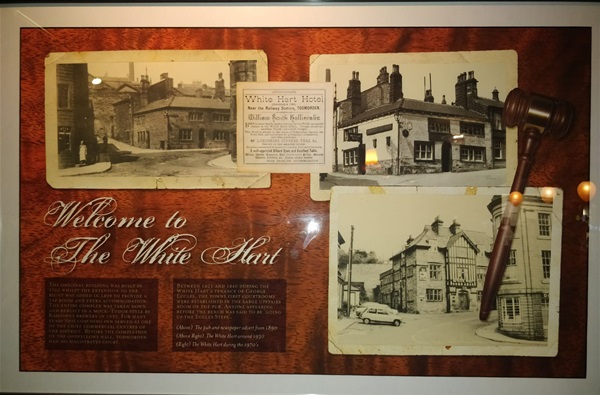
This text reads: The original building was built in 1728 whilst the extension to the right was added in 1899 to provide a tap room and extra accommodation. The entire complex was taken down and rebuilt in a mock Tudor style by Ramsdess Brewery in 1935. For many years this coaching inn served as one of the chief commercial centres of the district. Before the completion of the Oddfellows Hall. Todmorden had no magistrate’s court.
Between 1821 and 1840 during The White Hart’s tenancy of George Eccles, the town’s first courtrooms were established in the large upstairs room of the pub. Anyone appearing before the bench was said to be ‘going up the Eccles Steps’.
Above: The pub and newspaper advert from 1890
Above right: The White Hart around 1930
Right: The White Hart during the 1970s.
Illustrations and text about the legend of the white hart.
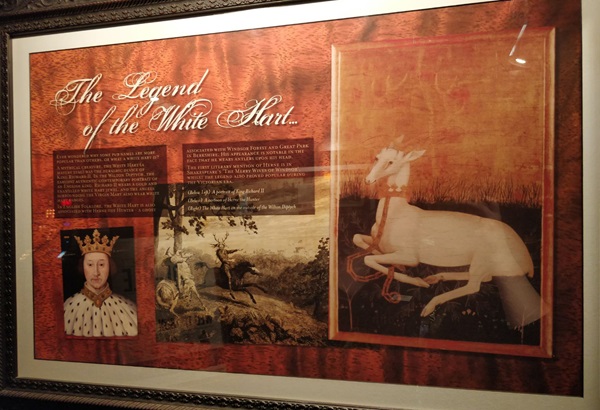
This text reads: Ever wondered why some pub names are more popular than others. Or what a white hart is?
A mythical creature, the white hart (a mature stag) was the heraldic device of King Richard II. In the Walton Diptych, the earliest authentic contemporary portraits of an English King, Richard II wears a gold and enamelled white hart jewel, and the angels surrounding the Virgin Mary also wear white hart badges.
In English folklore, the white hart is also associated with Herne the Hunter – a ghost associated with Windsor Forest and Great Park in Berkshire. His appearance is notable in the fact that he wears antlers upon his held.
The first literary mention of Herne is in Shakespeare’s The Merry Wives of Windsor, whilst the legend also proved popular during the Victorian era.
Below left: A portrait of King Richard II
Below: A cartoon of Herne the Hunter
Right: The White Hart on the outside of the Wilton Diptych.
A photograph and text about Sir John Douglas Cockcroft.
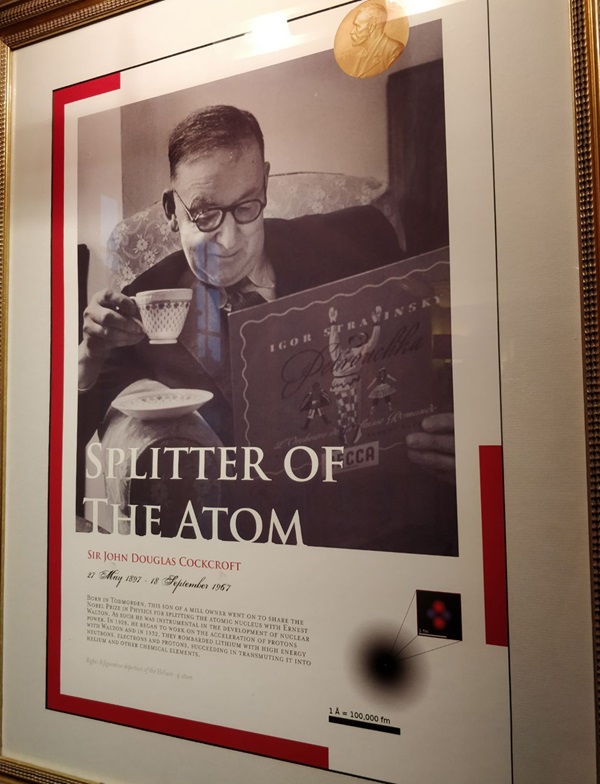
This text reads: Born in Todmorden, this son of a mill owner went on to share the Nobel Prize in Physics for splitting the atomic nucleus with Ernest Walton. As such he was instrumental in the development of nuclear power. In 1928, he began to work on the acceleration of protons with Walton and in 1932 they bombarded lithium with high energy neutrons, electrons and protons, succeeding in transmitting it into helium and other chemical elements.
Old photographs of workers in Todmorden, including hay-making in Cornholme, 1902.
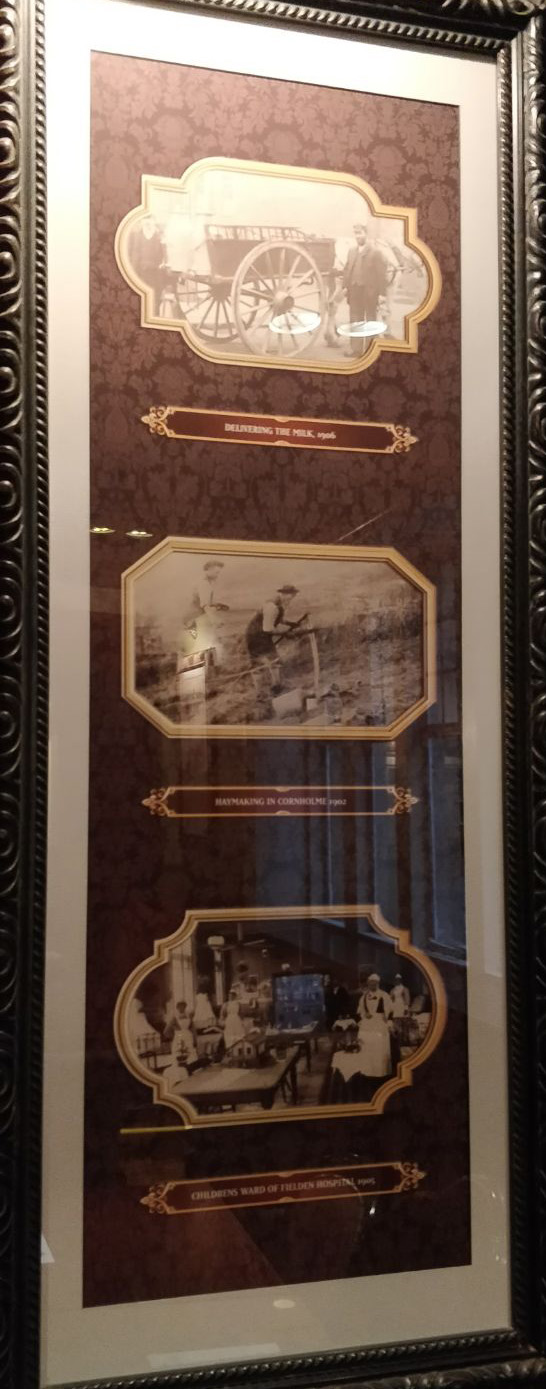
A photograph and text about Sir George Wilkinson.
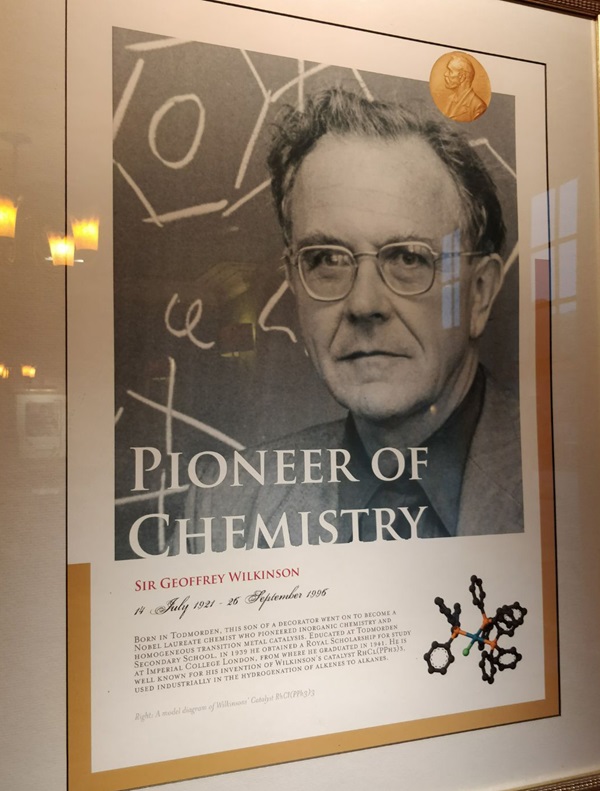
The text reads: Born in Todmorden, this son of a decorator went on to become a Nobel laureate chemist who pioneered in organic chemistry and homogeneous transition metal catalysis. Educated at Todmorden Secondary School, in 1939 he obtained a royal scholarship for study at Imperial College London, from where he graduated in 1941. He is well known for his invention of Wilkinson’s catalyst RhCl(PPh3)3, used industrially in the hydrogenation of alkene to alkanes.
A photograph and text about Todmorden Railway Station.
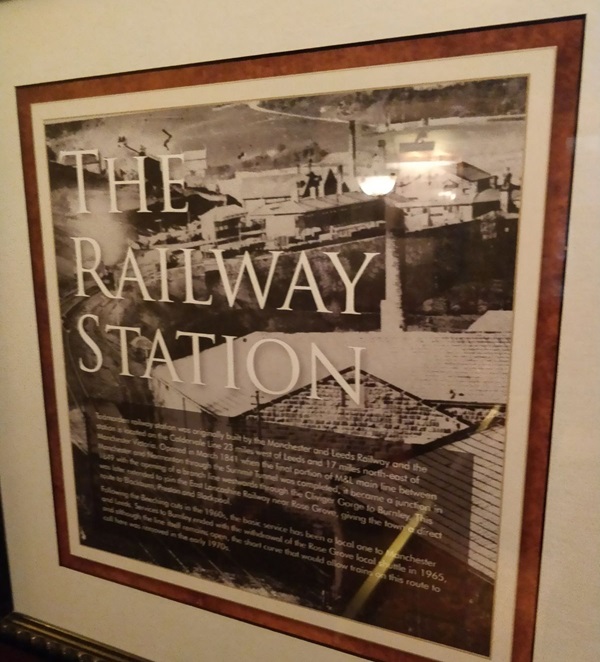
The text reads: Todmorden Railway Station was originally built by the Manchester and Leeds Railway and the station is located on the Caldervale Line 23 miles west of Leeds and 17 miles north east of Manchester Victoria. Opened in March 1841 when the final portion of the M&L main line between Manchester and Normanton through the Summit Tunnel was completed, it became a junction in 1849 with the opening of a branch line westwards through the Cliviger Gorge to Burnley. This was later extended to join the East Lancashire Railway near Rose Grove, giving the town a direct route to Blackburn, Preston and Blackpool.
Following the Beeching cuts in the 1960s, the basic service has been a local one to Manchester and Leeds. Services to Burnley ended with the withdrawal of the Rose Grove local shuttle in 1965 and although the line itself remains open, the short curve that would allow trains on this route to call here was removed in the early 1970s.
A photograph and text about the history of Todmorden.
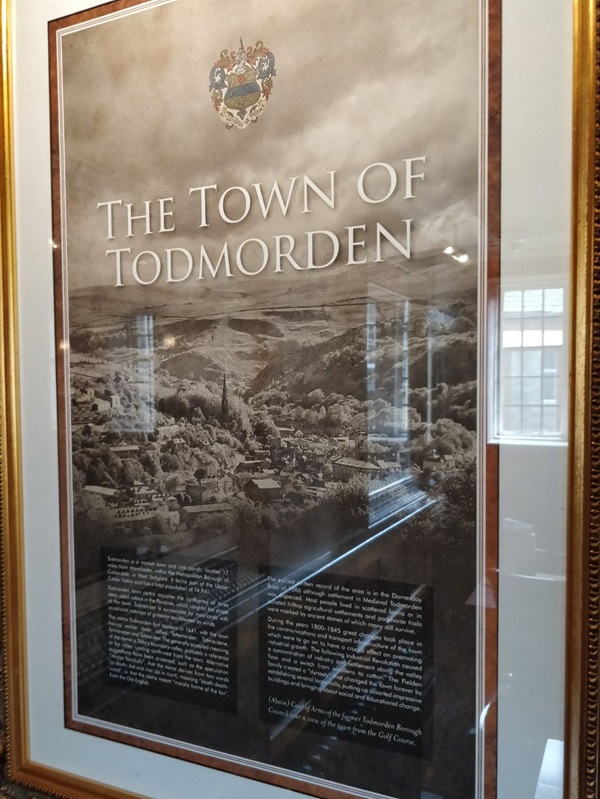
The text reads: Todmorden is a market town and civil parish, located 17 miles from Manchester, within the Metropolitan Borough of Calderdale, in West Yorkshire. It forms part of the Upper Calder Valley and has a total population of 14,941.
Todmorden town centre occupies the confluence of three steep sided valleys in the Pennines, which constrict the shape of the town. Todmorden is surrounded by moorlands with occasional outcrops of gritstone sandblasted by winds.
The name Todmorden first appears in 1641, with the town having earlier been called Tottemerden, Totmardene, Totmereden and Totmorden. The generally accepted meaning of the name is Totto’s boundary valley, probably a reference to the valley running north west from the town. Alternative suggestions have been proposed, such as the speculation “maybe fancifully”, that the name derives from two words for death: tod and more (as in mort), meaning ‘death-death-wood’, or that the name meant “marshy home of the fox”, from the Old English.
Photographs and text about Mons Mill.
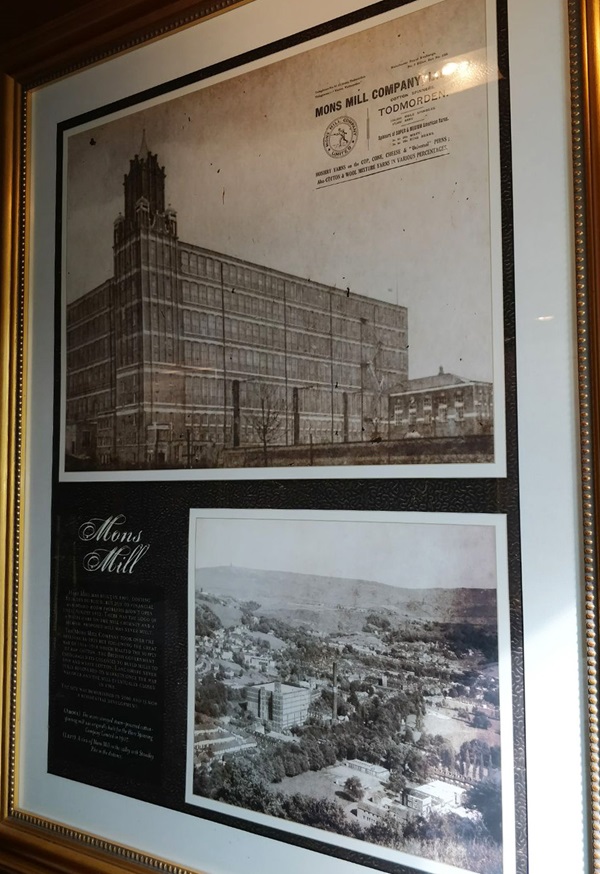
The text reads: Hare Mill was built in 1907, costing £218,285 to build, but due to financial and boardroom problems, didn’t open until August 1912. There was the logo of a white hare on the mill chimney and a second, proposed mill was never built.
The Mons Mill Company took over the building in 1919 but following the Great War of 1914-18 which halted the supply of raw cotton, the British government encouraged its colonies to build mills to spin and weave cotton. Lancashire never fully recovered its markets once the war was over and the mill eventually closed in 1968.
The site was demolished in 2000 and is now a residential development.
Above: The seven storeyed steam-powered cotton=-pinning mill was originally built for the Hare Spinning Company Limited in 1907
Left: A view of Mons Mill in the valley with Stoodley Pike in the distance.
Photographs and text about Keith Noel Emerson.
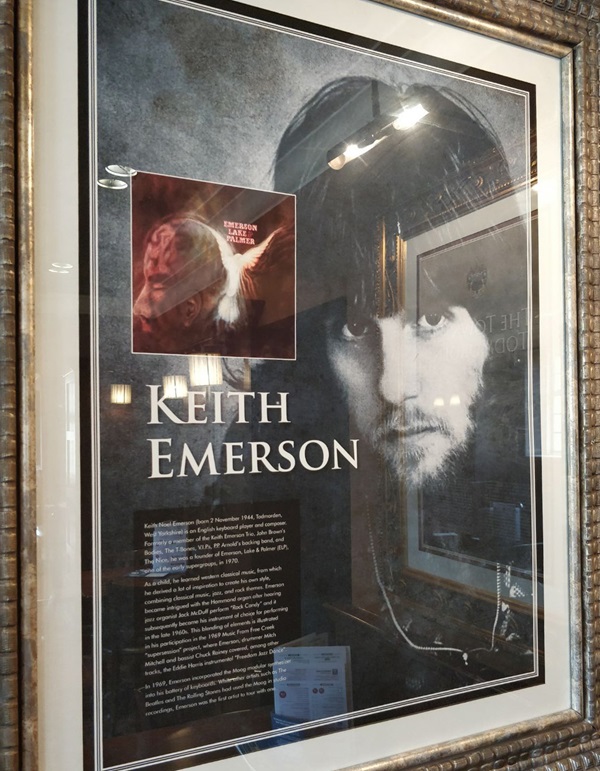
The text reads: Keith Noel Emerson (born 2 November 1944, Todmorden, West Yorkshire) is an English keyboard player and composer. Formerly a member of the Keith Emerson Trio, John Brown’s Bodies, The T-Bones, VIPs, PP Arnold’s backing band and The Nice, he was the founder of Emerson, Lake and Palmer (ELP), one of the early super groups, in 1970.
As a child, he learned western classical music, from which he derived a lot of inspiration to create his own style, combining classical music, jazz, and rock themes. Emerson became intrigued with the Hammond organ after hearing jazz organist Jack McDuff perform Rock Candy and it subsequently became his instrument of choice for performing in the late 1960s. This blending of elements is illustrated in his participation in the 1969 Music Free From Creek “supersession” project, where Emerson, drummer Mitch Mitchell and bassist Chuck Rainey covered, among other tracks, the Eddie Harris instrumental Freedom Jazz Dance.
In 1969, Emerson incorporated the Moog modular synthesizer into his battery of keyboards. While other artists such as The Beatles and The Rolling Stones had used to Moog in studio recordings, Emerson was the first artist to tour with one.
A photograph and text about the Lancashire-Yorkshire boundary.
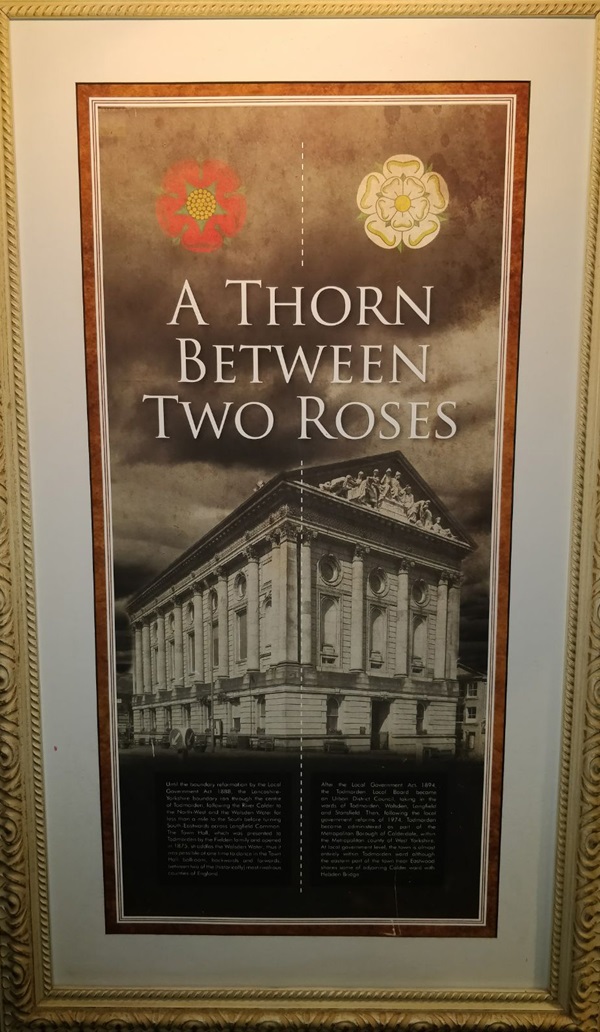
The text reads: Until the boundary reformation by the Local Government Act 1888, the Lancashire-Yorkshire boundary ran through the centre of Todmorden, following the River Calder to the north west and the Walsden Water for less than a mile to the south before turning south eastwards across Langfield Common. The Town Hall, which was presented to Todmorden by the Fielden family and opened in 1975, straddles the Walsden Water; thus it was possible at one time to dance in the Town Hall ballroom, backwards and forwards, between two of the (historically) most rivalrous counties of England.
After the Local Government Act, 1894, the Todmorden Local Board became an Urban District Council, taking in the wards of Todmorden, Walsden, Langfield and Stansfield. Then, following the local government reforms of 1974, Todmorden became administered as part of the Metropolitan Borough of Calderdale, within the Metropolitan country of West Yorkshire. At local government level, the town is almost entirely within Todmorden ward although the eastern part of the town near Eastwood shares some of adjoining Calder was with Hebden Bridge.
Photographs and text about Waterside Mill.
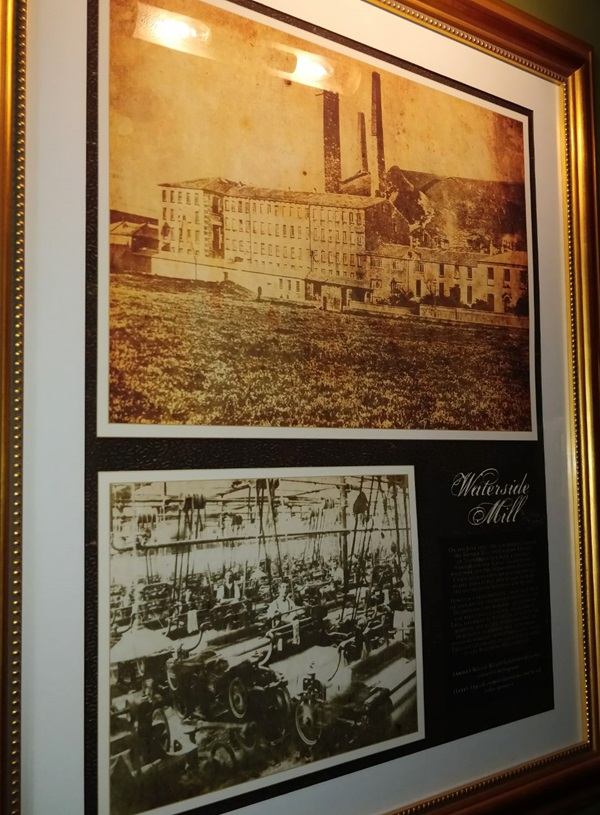
This text reads: On 4 June 1832, he government passed The Reform Bill, which John Fielden of Todmorden had been a staunch campaigner for. Great Celebrations followed and the Todmorden Political Union held an open air dinner for 350 people and a public procession to mark the occasion on Saturday 4 August.
However a week previous, there had been an even bigger celebration involving the Fielden's factory workers, all of whom had been given a holiday to celebrate. They assembled at Waterside at 8.30 in the morning and by the afternoon they’re procession numbered 1500.
Above: Waterside Mill with the field where the workers celebrated in the foreground
Left: a typically cramped industrial space that the mill workers operated in.
An illustration and text about the murder of Reverend Plow.
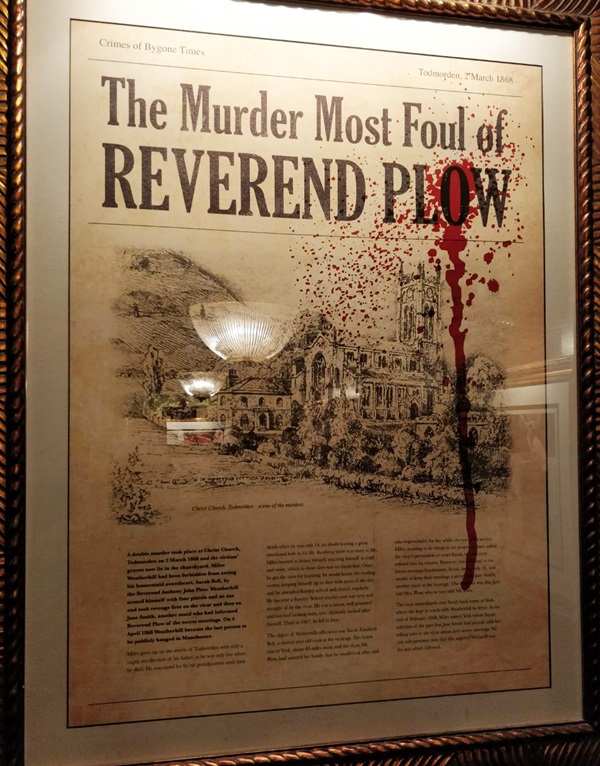
This text reads: A double murder took place at Christ Church, Todmorden on 2 March 1868 and the victim’s graves now lie in the churchyard. Miles Weatherhill had been forbidden from seeing his housemaid sweetheart, Sarah Bell, by the Reverend Anthony John Plow. Weatherhill armed himself with four pistols and an axe and took revenge first on the vicar and then on Jane Smith, another maid who had informed Reverend Plow of the secret meetings. On 4 April 1868 Weatherhill became the last person to be publicly hanged in Manchester.
Miles grew up on the streets of Todmorden with only a vague recollection of his father, as he was only five when he died. He was cared for by his grandparents until their death when he was only 14, no doubt leaving a great emotional hole in his life. Realising there was more to life, Miles wanted to better himself, teaching himself to read and write, which in those days was no mean feat. Once he got the taste for learning, he would haunt the reading rooms, keeping himself up to date with the news of the day and he attended Sunday school and church regularly. He became a Sunday school teacher and was very well thought of by the vicar. He was a smart, well-groomed and not bad looking man, who obviously looked after himself. Then in 1867, he fell in love.
The object of Wetherhill's affections was Sarah Elizabeth Bell, a sixteen year old cook at the vicarage. Her home was in York, about 60 miles away, and the vicar, Mr Plow, had assured her family that he would look after and take responsibility for her whilst she was in his service. Miles, wanting to do things in the proper manner, asked the vicar’s permission to court Sarah, but vicar refused him his request. However, this only lead to the lovers meeting clandestinely. Sarah, being only 16, and unable to keep their meetings a secret, told Jane Smith, another maid at the vicarage. The outcome was the Jane told Mrs Plow, who in turn told Mr Plow.
Death when he was only 14, no doubt leaving a great emotional hole in his life. Realising there was more to life, Miles wanted to better himself, teaching himself to read and write, which in those days was no mean feat. Once he got the taste for learning, he would haunt the reading rooms, keeping himself up to date with news of the day and he attended Sunday school and church regularly. He became a Sunday School teacher and was very well thought of by the vicar. He was a smart, well-groomed and not bad looking man, who obviously looked after himself. Then in 1867, he fell in love.
The vicar immediately sent Sarah back home to York, where she kept in touch with Weatherhill by letter. At the end of February 1868, Miles visited York where Sarah told him of the part that Jane Smith had played, with her telling tales to the vicar about their secret meetings. We can only presume now that this angered Weatherhill into the acts which followed…
An oil painting entitled Towards Studley Pike, by Mike Acton.
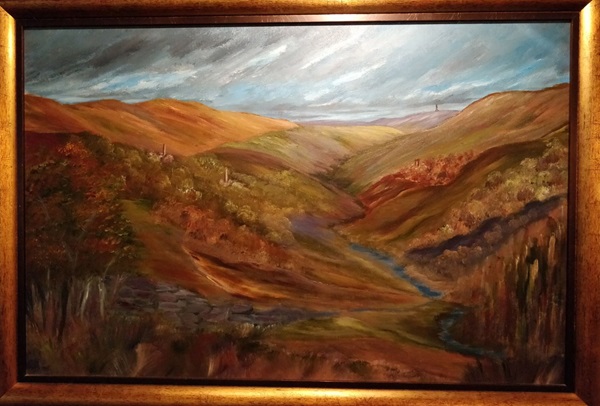
External photograph of the building – main entrance.
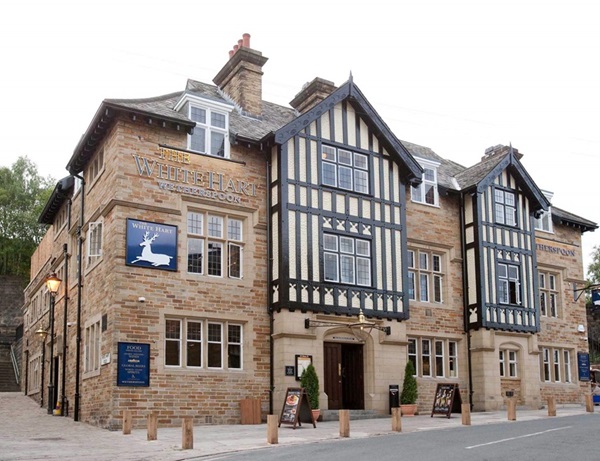
If you have information on the history of this pub, then we’d like you to share it with us. Please e-mail all information to: pubhistories@jdwetherspoon.co.uk